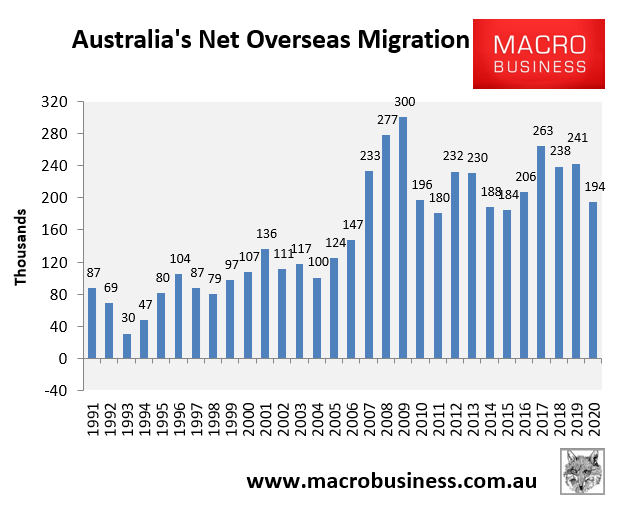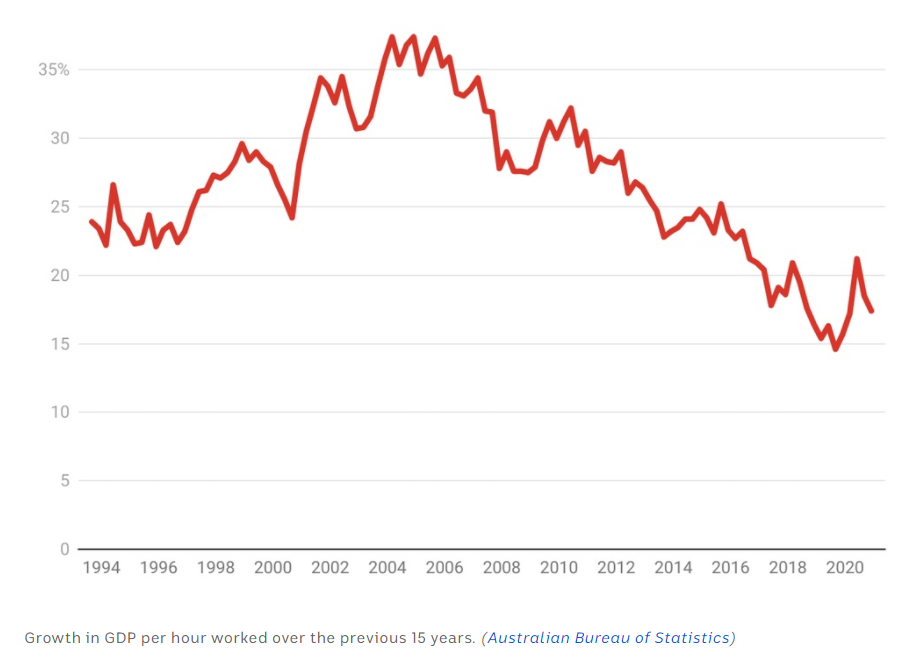The Conversation’s editor, Peter Martin, has penned an article bemoaning the collapse in Australia’s productivity growth since 2005:
According to Peter Martin:
- The high point for Australia’s productivity growth was 2005 (as shown above), “driven by an ever-building surge in output per working hour (“productivity”)”.
- But from 2005 onwards, Australia’s productivity growth collapsed. “In the 15 years since, Australia’s output per working hour (productivity) has grown by just 17 per cent”.
- Martin notes that “things we do these days are harder to automate” mainly because 80% of Australians now work in services jobs.
- He then concludes that “we might be coming up against hard limits in the amount we can squeeze out of each hour of paid work”.
- This decline in productivity growth will make it harder to sustain an aging population.
As we know, Peter Martin is a rabid supporter of the ‘Big Australia’ mass immigration policy (see here, here, here, and here). So it is no surprise that Martin conveniently omitted to mention that the ramp-up in immigration from 2005 has driven much of Australia’s productivity decline:

Australia’s immigration intake accelerated after 2005, coinciding with the collapse in labour productivity.
Australia’s net overseas migration (NOM) jumped from an average of 89,000 between 1991 and 2004 to an average of 215,000 between 2005 and 2020 – an annual average increase in immigration of 140%.
This surge in immigration would have adversely impacted Australia’s productivity in three ways.
First, the massive rise in population growth created chronic infrastructure bottlenecks across the capital cities, driving up congestion costs. It also encouraged growth in low productivity people-servicing industries.
The infrastructure investment required to keep pace with population growth was also much more expensive than in the past, due to diseconomies of scale (e.g. tunnelling and land buy-backs).
Second, the migrants that Australia imported are typically less productive, as evidenced by them earning lower than median wages and suffering higher unemployment and underemployment than the Australian-born population (see here).
Third, the downward pressure on wages caused by mass immigration necessarily disincentivises employers from investing in labour-saving technologies and automation to lift productivity (see here and here). After all, why invest in these productivity enhancements when you can simply bring in cheap migrant workers to do the task?
In summary, if you want to know why Australia has suffered simultaneously from low wage growth and low productivity growth, look no further than the nation’s mass immigration policy supported by the likes of Peter Martin.
Restoring the mass immigration ‘Big Australia’ policy post pandemic would repeat the same mistakes and consign the nation to a low wage, low productivity future.


